She feels really easy and comfortable to sail, even in a good breeze and a chop.

There’s nothing quite like the new Tino 570 HS centre-console on the New Zealand market and quite possibly nothing like it anywhere in the world.
The 570 HS is the first of a limited range of Tino trailer boats from a Tauranga builder brave enough to be different. A completely new model, from its brass keel rubbing strip to its sculpted composite Bimini top, this beautifully-finished newcomer combines attributes of a centre-console sports boat, family bow rider and RIB yacht tender.

The driving force behind Tino Marine is Nicholas Fenton, whose 17-year marine industry pedigree belies his apparent youth. Nick started out in the marine industry with Tristram Marine in Hamilton, building trailer boats on the factory floor.
He soon realised working in a lamination shop on someone else’s boats ultimately wasn’t for him: Nick wanted to build boats that reflected his own take on style and performance. He decided to go back to school, earning an Honours degree in Marine Design.
Armed with his new qualifications, he took work designing experimental hydrofoils and alloy boats, though his passion for composites remained strong. A stint overseas followed, project managing superyacht refits in Italy and USA, a new-build project with Sunseeker and various crewing positions. Before heading home, he also took the opportunity to earn his skipper’s ticket.
The Tino 570 HS is the culmination of seven years of effort, with Nick working the last two years on the project full-time. The boat draws conceptual inspiration from the luxury superyacht tenders Nick became familiar with overseas.
“At its core, it’s a yacht tender with the hull and decks and high-spec fit-out configured accordingly,” says Nick, but the versatile layout has far wider application and its striking good looks and luxury finish will appeal to all sorts of boaters.
SBM stability
A salient feature of the Tino is its closed-cell foam pontoons, or SBM (solid-core buoyancy module), which provide extra buoyancy and stability at rest when the boat is heavily loaded. They also provide protection when coming alongside, and while it’s not a substitute for fenders, the SBM is tough and will cope with a fair amount of abuse at docking time.
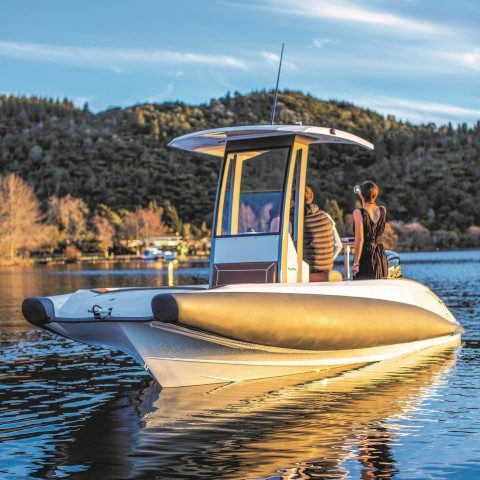
Nick and the team spent considerable effort getting the three-layer foam sandwich construction right, especially the protective urethane elastomer sheathing that’s tough enough to resist fish hooks or gaffs and easily repaired if torn. The SBM can be completely resurfaced if required and is available in several colours.
The SBM only contacts the water when it’s buoyancy is needed: if the boat is heavily loaded or there are several passengers on one side. When the 570 HS is underway, the pontoons are completely clear of the water, with the hull providing all the lift. Nor do the contoured D-profile pontoons compromise the boat’s interior volume, allowing extra-wide side pockets.
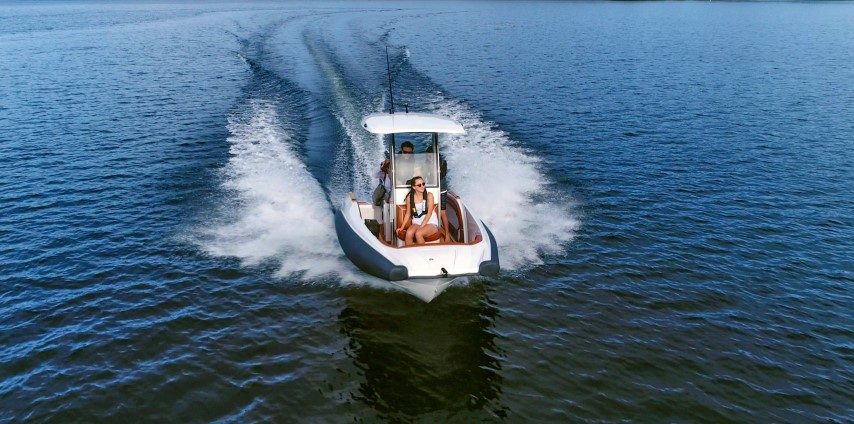
The Tino’s hull is solid GRP. It features a 19.3o deadrise at the transom, a pronounced spray rail, modest strakes and plenty of flare in the bows for a dry ride. The bow area is unusual: the boat’s tapered pontoons don’t meet at the stem, which is squared-off for maximum usable space.
The bow incorporates the fairlead, bollard and a moulded anchor locker – the optional carbon-fibre hinge is very classy – as well as a generous seating area, bow-rider-style. The hull’s medium entry is fine enough to provide a comfortable ride but offers sufficient volume to cope with a couple of bodies riding up front and the boat demonstrates good manners in a following sea.
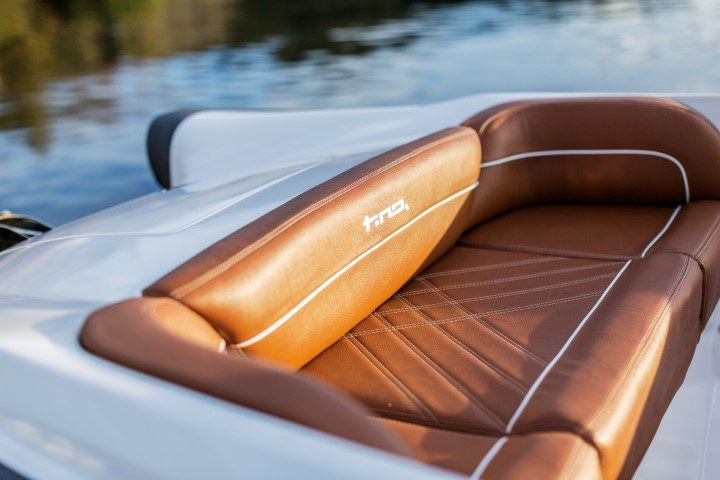
Nick and his team developed the moulds in-house using CAD and CNC technology. The fibreglass lamination is done under licence by a GRP specialist in Tauranga, as is the composite hardtop bimini. Upholstery is also out-sourced.
Stylish hardtop
The hardtop is not only stylish, it’s also very light, thanks to exotic construction. A tall safety glass screen provides good protection behind the console and there are plans for side curtains and a bowrider-style tonneau cover for the bow area to extend the Tino’s utility in inclement weather or keep gear dry.
Box-section aluminium supports anchor the centre console and secure the hardtop. They’re almost sculptural: gently curved, smooth and painted with no visible fastenings – another example of the builder’s superb attention to detail. The cabling for the LED hardtop downlights, navigation lights, aerial and such like is run inside the supports.

There’s room for customisation, says Nick, especially around areas such as the console seat module and transom set-up. The demo boat has a simple moulded seat base with a padded, upholstered cushion (storage under) and an aft-facing cut-out accommodating a good-sized chilly bin, but Nick plans to offer several options, depending on the customer.
Multi-purpose layout
The transom was equipped with a ski-pole and a drop-in Manta bait table and a seat, but Tino Marine can offer different configurations. Nick was still awaiting delivery of the transom boarding ladder, which will bolt to the starboard side. The swim platforms are usefully wide and deep.
Inside the transom locker, the battery box is well-protected though it is at cockpit floor level. Two bilge pumps, one an automatic 650gph and a back-up emergency 1100gph unit on a float switch keep the bilges dry. The cockpit drains into the bilge via a pair of custom CNC-cut stainless-steel scuppers.
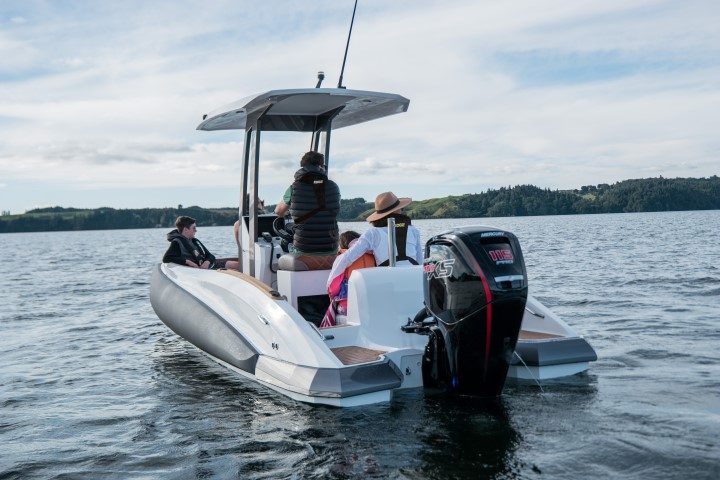
The cockpit area is spacious for a sub-6m boat. Gunwale height is closer to a RIB’s than a blue-water powerboat, but they still provide support at mid-thigh, footing is excellent with good toe-room and the hull is very stable at rest, so the cockpit feels secure enough. The boat lacks transom doors, step-throughs providing easy access to the swim platforms, but there’s plenty of buoyancy aft, so little danger of taking seas over the stern.
There’s a full cockpit liner with integrated underfloor lockers fore and aft. Brown Ultralon flooring (with fancy black stencilling, some of it curved) matches the boat’s high quality stitched and monogrammed marine vinyl upholstery, including cockpit side panels. The upholstery and ceiling panels are hardwood-backed, sealed against water ingress and secured with Fast Mount fastenings. Teak covering boards on the coamings are a nice touch.
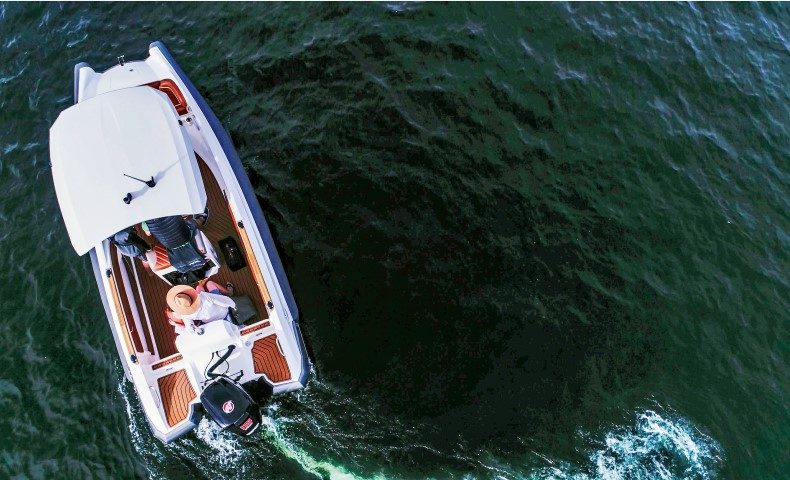
This is a centre-console boat with a flush deck, so there’s easy access to the bow area. As well as the aft-facing two-person seat in the bow, there’s a forward-facing seat in front of the console; both have storage under the squabs. The underfloor wet locker is a decent size too.
There’s plenty of room to walk past the console without sidling and the Tino is well provided with handholds, whether standing or sitting to drive. LED lighting illuminates the cockpit at floor level, there are downlights in the hardtop, courtesy lights on the swim platforms and underwater lights as well.
High-tech electronics
An unusual luxury for a boat of this size is Tino’s use of C-Zone digital switching. The vessel’s systems are controlled from the Garmin multi-function display, or from a smartphone or tablet. C-Zone offers numerous advantages, including the ability to set up various one-touch modes, streamlined wiring, improved efficiency and unmatched versatility. It is more usually found on much larger vessels.
The vessel is also equipped with Wi-Fi and Bluetooth, so you can monitor the sounder from an iPad in the bows, along with a killer Fusion four-speaker sound system. LED lighting, including deck floods, is by Hella Marine, except the underwater lights on the transom. Nav lights are integrated into the hardtop supports and Tino have fitted a through-hull transducer for the Garmin sounder module.

Although the boat would make an excellent luxury yacht tender, it’s layout and equipment make equally suitable for sportfishing, scuba diving or towsport duties. Wide side pockets will hold dive bottles, or they can be strapped to the back of the seat. The boat is stylish enough to stand out in any company, but also eminently practical – a real all-rounder with lots of classy touches.
New Mercury
Power for the 570 is courtesy of Mercury’s new 115hp Pro XS four-stroke – until recently Mercury XS outboards have always been high-performance two-strokes. This 2.1-litre four-cylinder model’s horsepower is a nominal 115, but it performs like a considerably gruntier powerplant.
With a re-mapped ECU, it revs 300rpm higher than the standard Mercury 115hp. More revs equal more horsepower. The large displacement engine offers plenty of low-down torque and easily copes with the 570’s modest mass, even when the Tino is loaded with people, as bowrider-style boats often tend to be.
This is a nimble, very responsive little boat. The custom Italian steering wheel tilts to suit any driver and Tino can also adjust the distance between the console and the seat unit to suit individual customers. There’s some dry stowage in the console locker, as well as a handy tray under the seat, and moulded drink-holders with stainless steel inserts are a feature of the console, as well as the cockpit and bow areas.
The ride feels very assured and the boat is a dry-runner – important for any centre-console – the spray curling away nicely amidships. The 570 turns flat and is very responsive to engine trim inputs, though the Mercury has a single-stage ram so things happen fast when you thumb the trim button.
The Tino gives the impression it’s a bigger boat than it this, largely because the deck configuration makes the most of the available internal space. Vision from the helm is, of course, excellent in any centre-console, and the Tino’s large windscreen offers better than average protection.
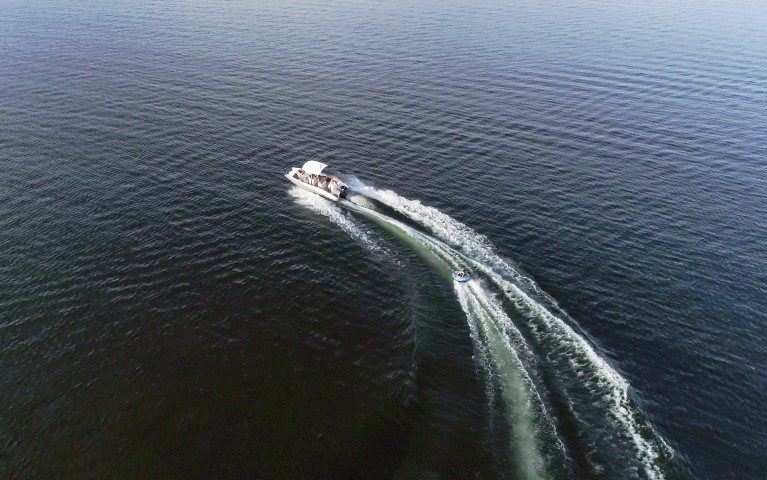
With the Pro XS 115 and Mercury’s Command Thrust lower unit, acceleration is quick, the boat popping up onto the plane in seconds. She weighs-in at 870kg, plus engine – 1,400kg on the road with a DMW-built, dual-axle, unbraked trailer with alloy wheels and LED lights.
At wide open throttle (6,200rpm) we saw a best speed of 36.3 knots, running with the tide (34.5 knots against the tide). The boat cruises along nicely between 4,500 and 5,000rpm making 23-27 knots and using between 22 and 26 litres per hour. The underfloor fuel tank holds 100 litres; 150 litres is an optional upgrade. Fresh water tanks are also available.
She feels really easy and comfortable to sail, even in a good breeze and a chop.
At first glance the boat appears to be a large centre console, although hidden beneath the console and forward area is a sizeable overnight cabin.
With classic styling, good performance and class-leading ride and handling, there’s a lot to like about the Caribbean 32.
Solar panels on the vast roof help keep the batteries charged.